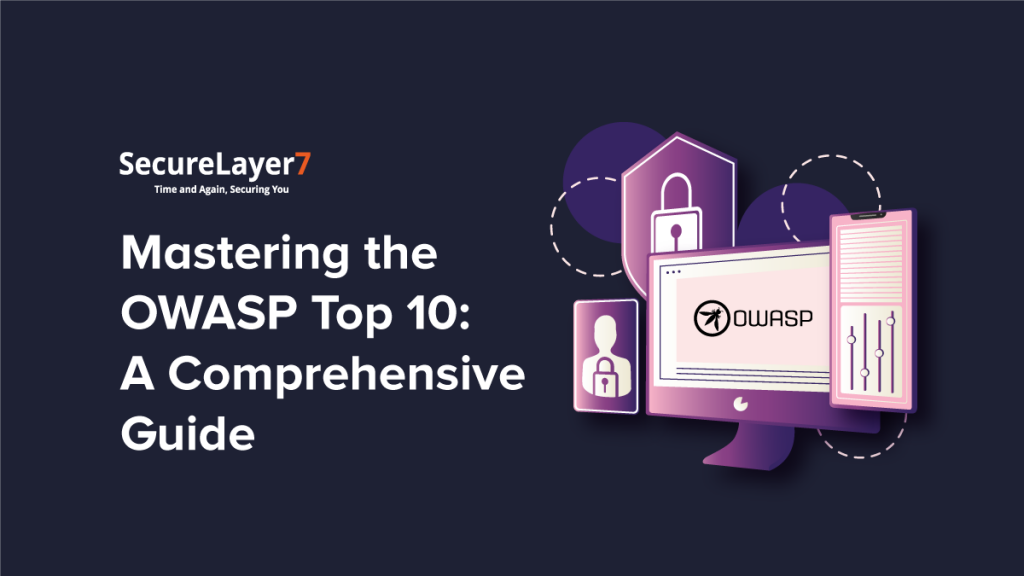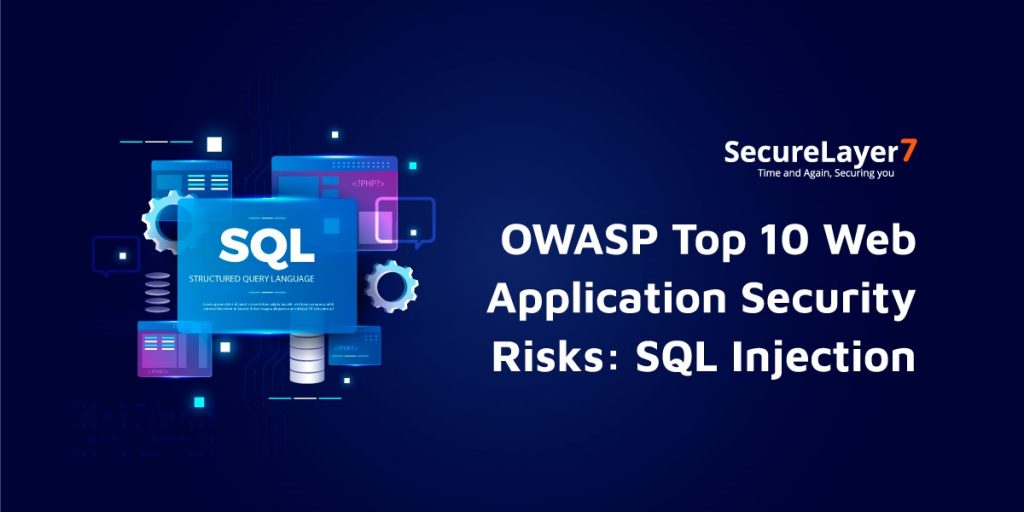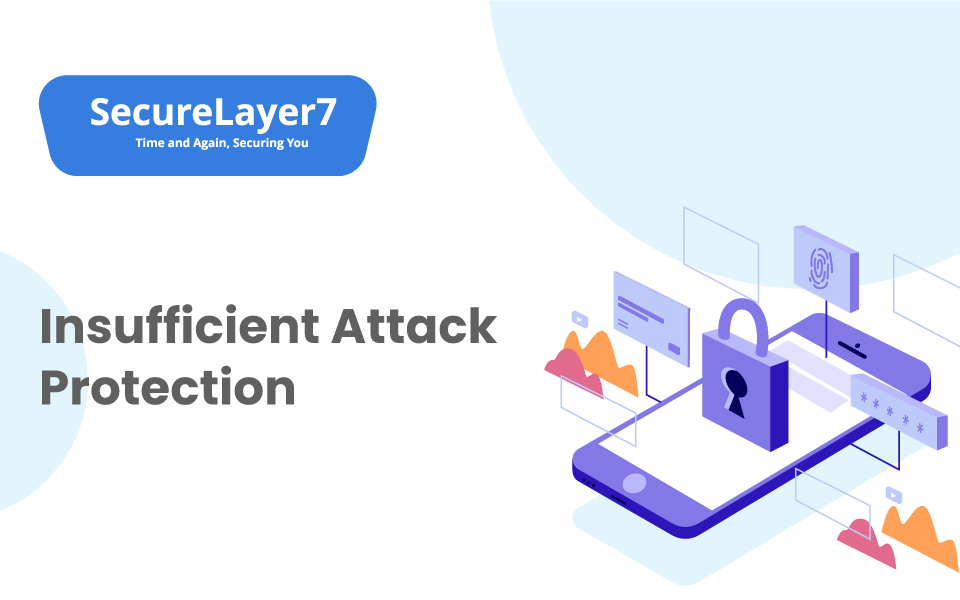
Kubernetes Security: 5 Best Practices To Follow
June 28, 2023
Cheap Pentesting For Bootstrapped Startups
July 5, 2023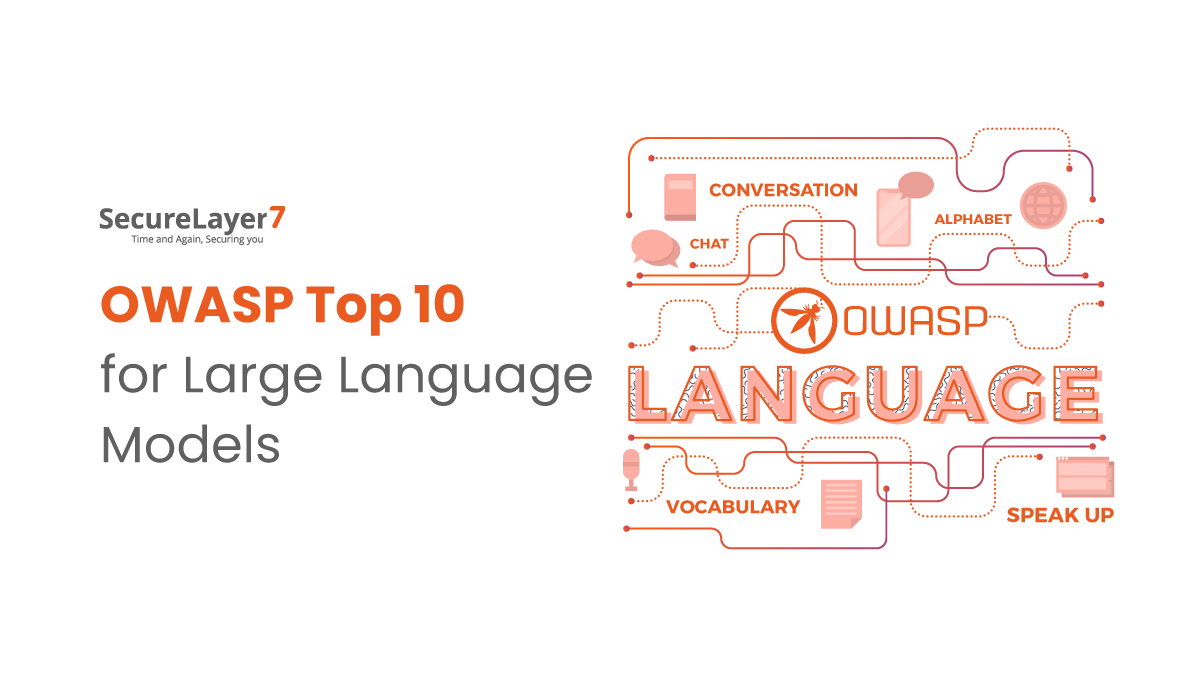
LLM (Large Language Models) applications have revolutionized various fields, enabling advanced language processing capabilities. However, these applications are not immune to vulnerabilities and security risks, including prompt injections.
The latest creation, the OWASP Top 10 List for Large Language Models version 0.1, is a battle plan designed to safeguard architects, testers, developers, designers, and managers in the realm of language models.
In this blog, we embark on an adventure through the OWASP Top 10, unlocking the secrets that lie within. From daring adversarial attacks to the subtle art of data poisoning, we explore the hidden vulnerabilities that can threaten the very fabric of these remarkable AI systems.
So Let us get started!
OWASP Top 10 List for Large Language Models version 0.1
Below is the list of cardinal vulnerabilities for AI applications built on LLMs!
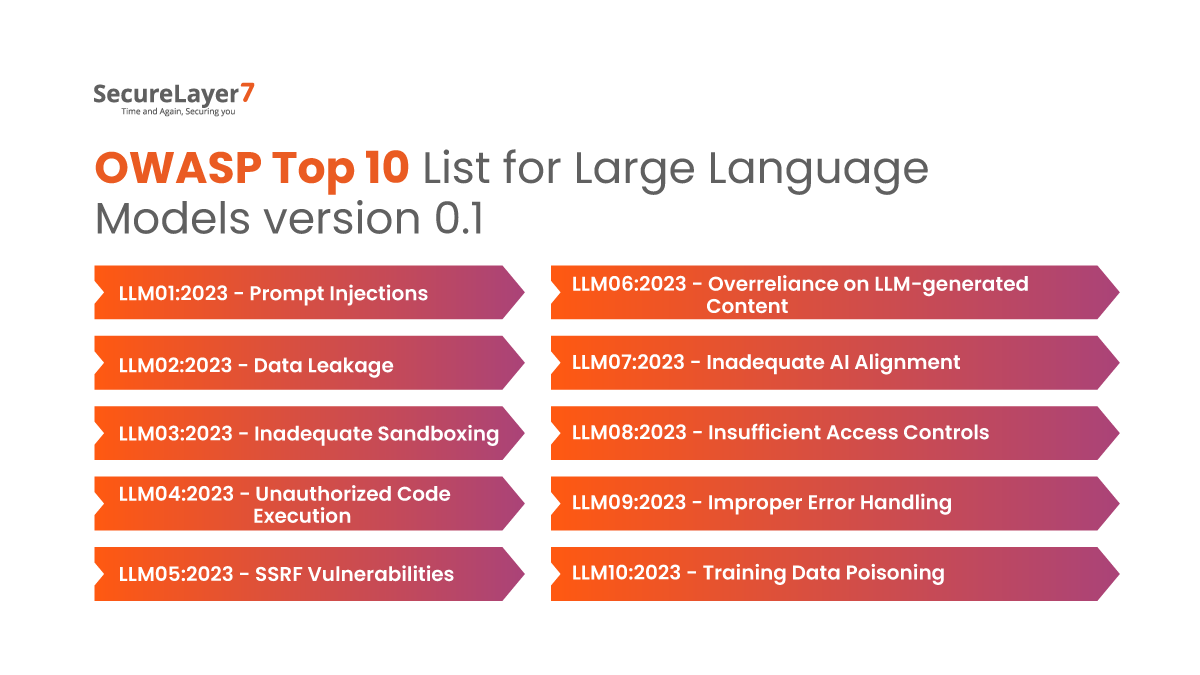
Let’s delve deeper into each of them.
1. LLM01:2023 – Prompt Injections: Manipulating the Language Model
Prompt injections pose significant security risks to Language Model (LM) applications by exploiting vulnerabilities in the input processing and understanding of the model.
These vulnerabilities can have severe consequences, including data leakage, unauthorized access, and other breaches.
It is crucial to understand and address these risks to ensure the security and integrity of LM applications.
Let us look at some common vulnerabilities that can be incurred by Peompt Injection.
Common Prompt Injection Vulnerabilities in LLM Applications
LLM applications are susceptible to various data leakage vulnerabilities that can be exploited through prompt injections.
These vulnerability types include:
- Manipulating the LLM: Crafted prompts can deceive the LLM into revealing sensitive information, bypassing content filters or restrictions by using specific language patterns or tokens. Attackers exploit weaknesses in tokenization or encoding mechanisms to extract confidential data or gain unauthorized access.
- Contextual Manipulation: Misleading the LLM by providing a misleading context within prompts can lead to unintended actions. Attackers may trick the model into generating inaccurate or harmful outputs, influencing user behaviour or system behaviour in undesired ways.
How to Prevent Prompt Injections in LLM Applications
To enhance the security of LLM applications and mitigate prompt injection risks, the following measures should be implemented:
1. LLM Application Security Testing
Conduct comprehensive security testing, including specific assessments for prompt injection vulnerabilities. This ensures that potential weaknesses are identified and addressed before deployment.
2. Strict Input Validation and Sanitization
Implement robust input validation and sanitization processes to validate user-provided prompts. By thoroughly checking and filtering inputs, organizations can prevent the acceptance of unauthorized or malicious prompts.
3. Context-Aware Filtering
Utilize context-aware filtering mechanisms to detect and prevent prompt manipulation. Analyze prompt context against predefined rules to identify suspicious patterns and block prompt injections, even when attackers attempt to use specific language patterns, tokens, or encoding mechanisms.
4. Regular Updates and Fine-Tuning
Continuously update and fine-tune the LLM application to improve its understanding of malicious inputs and edge cases. By staying proactive in addressing known vulnerabilities, the application becomes more resilient against prompt injection attacks.
5. Monitoring and Logging
Implement comprehensive monitoring and logging of LLM application interactions. By tracking prompts received and generated outputs, organizations can detect and analyze potential prompt injection attempts, enabling timely response and mitigation.
Examples Of Attack Scenarios
- Information Disclosure: An attacker crafts a prompt that tricks the LLM into revealing sensitive information, such as user credentials or internal system details. By making the model think the request is legitimate, the attacker successfully extracts confidential data.
- Content Filter Bypass: A malicious user bypasses a content filter by leveraging specific language patterns, tokens, or encoding mechanisms that the LLM fails to recognize as restricted content. This allows the user to perform actions that should be blocked, compromising the integrity and security of the system.
Organizations can enhance the security of their LLM applications and mitigate potential risks by implementing strong security measures, conducting frequent testing, and remaining vigilant against prompt injection vulnerabilities.
2. LLM02:2023 – Data Leakage
Data leakage is a critical concern in the realm of Language Model (LM) applications. The inadvertent or unauthorized disclosure of sensitive information can lead to severe consequences, including privacy breaches, compromised intellectual property, and regulatory non-compliance.
Common Data Leakage Vulnerabilities in LLM Applications
LM applications can be susceptible to various data leakage vulnerabilities, including:
- Improper Handling of Sensitive Data: Inadequate protocols for handling sensitive information within the LM application can result in unintended data exposure. This includes situations where sensitive data is inadvertently stored or transmitted in plain text or stored in easily accessible storage locations.
- Insufficient Access Controls: Weak access controls can allow unauthorized users or entities to gain access to sensitive data. Lack of proper authentication and authorization mechanisms increases the risk of data leakage and unauthorized data access.
- Insecure Data Transmission: Inadequately secured data transmission channels may expose sensitive information to interception and unauthorized access. Failure to utilize encryption protocols or secure communication channels can compromise the confidentiality of data during transit.
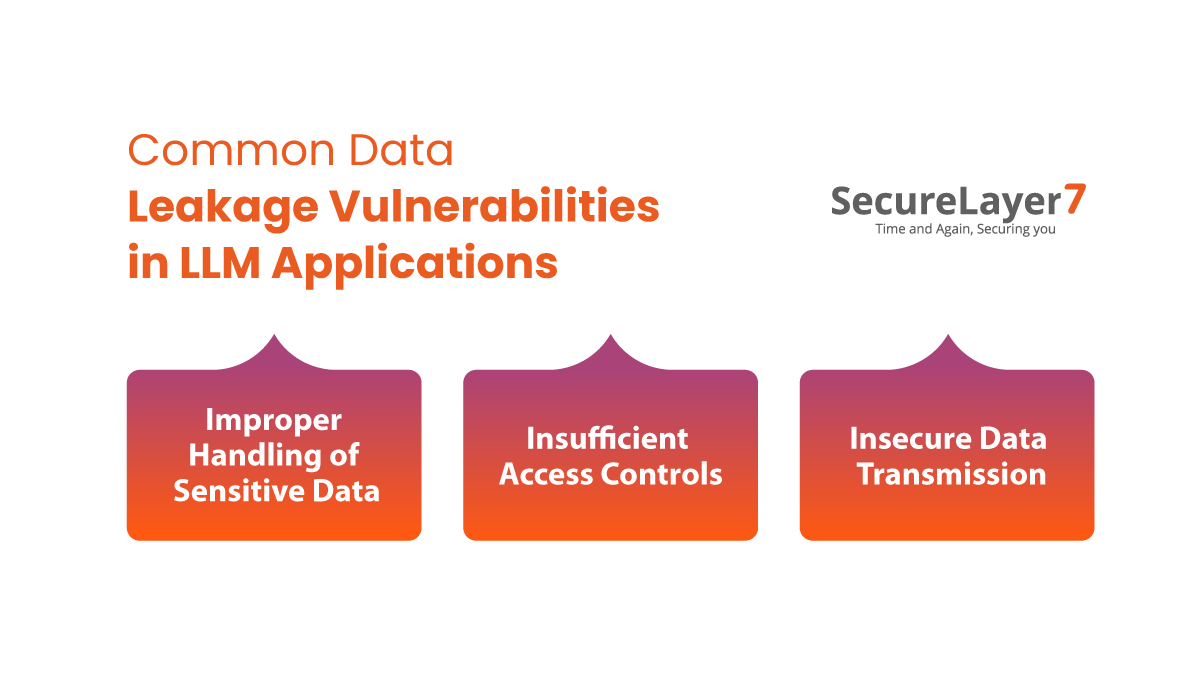
How to Prevent Data Leakage in LLM Applications
To mitigate the risks of data leakage in LM applications, it is crucial to implement robust security measures. Consider the following prevention strategies:
1. Data Classification and Handling
Implement a data classification scheme to identify and categorize sensitive information within the LM application. Apply appropriate security controls, such as encryption and access restrictions, based on the classification level of the data.
2. Access Controls and User Authentication
Implement strong access controls to ensure that only authorized users have access to sensitive data. Employ robust user authentication mechanisms, including multi-factor authentication, to prevent unauthorized access and data leakage.
3. Secure Data Storage
Apply industry-standard encryption techniques to safeguard sensitive data stored within the LM application. Utilize secure storage mechanisms and ensure that access to stored data is restricted to authorized personnel only.
4. Secure Data Transmission
Employ secure communication protocols, such as HTTPS, for data transmission between the LM application and other systems or users. Encrypt sensitive data during transit to prevent interception and unauthorized access.
5. Regular Security Audits and Testing
Conduct regular security audits and vulnerability assessments to identify and address potential weaknesses in the LM application’s data handling processes. Perform penetration testing to evaluate the resilience of the system against data leakage attacks.
Examples Of Data Leakage Scenarios
- Misconfigured Access Controls: A misconfigured access control mechanism allows unauthorized users to gain access to sensitive data within the LM application. As a result, confidential information is exposed, leading to potential data leakage and privacy breaches.
- Insecure Data Transmission: Sensitive data is transmitted over an insecure channel, such as an unencrypted network connection. An attacker intercepts the data during transit, compromising its confidentiality and potentially leading to data leakage.
By implementing robust security measures, including proper data handling, strong access controls, secure data storage and transmission, and regular security testing, organizations can significantly reduce the risk of data leakage in LM applications.
Proactive measures help ensure the confidentiality, integrity, and availability of sensitive information, safeguarding against potential data breaches and associated consequences.
3. LLM03:2023 – Inadequate Sandboxing
Inadequate sandboxing practices in Language Model (LM) applications can lead to significant security risks and potential exploitation by malicious actors.
This section explores the vulnerabilities associated with inadequate sandboxing and provides insights into preventing and mitigating these risks. It emphasizes the importance of robust sandboxing techniques to ensure the security and integrity of LM applications.
Inadequate sandboxing refers to insufficient isolation and containment of the LM application environment. When sandboxing is inadequate, the boundaries between the LM and the external systems or resources it interacts with are not well-defined, allowing unauthorized access and potential security breaches.
This lack of proper containment increases the risk of malicious activities, data exfiltration, and unauthorized system manipulation.
Common Vulnerabilities and Risks
Several vulnerabilities and risks are associated with inadequate sandboxing in LM applications, including:
- Unauthorized Access: Inadequate sandboxing can enable unauthorized access to the underlying system, compromising its security. Attackers may exploit vulnerabilities within the LM application to gain access to sensitive resources or execute malicious code.
- Data Exfiltration: Insufficient sandboxing may allow unauthorized extraction of data from the LM application or its connected systems. Attackers can exploit this vulnerability to steal sensitive information, compromising the confidentiality and integrity of the data.
- System Manipulation: Inadequate containment can lead to unauthorized manipulation of the LM application’s behaviour or the underlying system. Attackers may modify the behaviour of the LM, inject malicious code, or tamper with critical configurations, causing disruptions or compromising the system’s stability.
How to Prevent Inadequate Sandboxing in LLM Applications
To prevent and mitigate the risks associated with inadequate sandboxing in LM applications, the following measures should be considered:
1. Robust Sandbox Implementation
Implement a robust sandboxing mechanism that isolates the LM application from the underlying system and external resources. This includes employing technologies such as containerization, virtualization, or sandboxing frameworks to create secure and controlled execution environments.
2. Access Control and Privilege Separation
Enforce strict access controls and privilege separation within the LM application and its sandboxed environment. Ensure that only authorized entities have access to sensitive resources and restrict the execution of privileged operations.
3. Regular Security Patching and Updates
Keep the sandboxing framework and underlying system up-to-date with the latest security patches and updates. This helps address known vulnerabilities and mitigate the risk of exploitation.
4. Security Monitoring and Auditing
Implement continuous security monitoring and auditing mechanisms to detect any unauthorized activities or attempts to breach the sandbox. Monitor for suspicious behaviour, anomalous access patterns, and potential sandbox escape attempts.
Examples of Inadequate Sandboxing
- Unauthorized System Access: Inadequate sandboxing allows an attacker to exploit vulnerabilities within the LM application and gain unauthorized access to the underlying system. This can lead to unauthorized data access, system manipulation, and potential compromise of critical resources.
- Data Exfiltration: Insufficient sandboxing enables an attacker to extract sensitive data from the LM application or its connected systems. By bypassing containment measures, the attacker can exfiltrate valuable information, leading to data breaches and potential legal and reputational consequences.
Organizations can mitigate the risks associated with inadequate sandboxing in LM applications by adopting robust sandboxing techniques, enforcing strict access controls, regularly updating systems, and implementing comprehensive security monitoring.
It is crucial to establish proper containment and isolation of the LM environment to safeguard against unauthorized access, prevent data exfiltration, and protect the integrity of the application.
4. LLM04:2023 – Unauthorized Code Execution
Unauthorized code execution in Language Model (LM) applications presents a major security concern, with the potential for unauthorized access to systems, data breaches, and severe consequences.
Unauthorized code execution refers to the ability of an attacker to run malicious code within the LM application’s environment without proper authorization.
This can occur due to vulnerabilities in the application itself, inadequate input validation, or exploitation of weaknesses in the execution environment.
Unauthorized code execution enables attackers to gain control over the application, compromise system resources, and potentially perform malicious actions.
Common Vulnerabilities and Risks
Several vulnerabilities and risks are associated with unauthorized code execution in LM applications, including:
- Injection Attacks: Attackers can exploit input validation vulnerabilities to inject malicious code into the LM application. This includes SQL injection, OS command injection, and other similar attack techniques. Once the malicious code is executed, it can lead to unauthorized system access or data manipulation.
- Remote Code Execution: Vulnerabilities in the LM application’s execution environment, such as deserialization vulnerabilities or remote code execution vulnerabilities, can allow attackers to execute arbitrary code on the server or the underlying system. This can lead to a complete compromise of the application and unauthorized control over the system.
- Scripting Language Vulnerabilities: LM applications that support scripting languages may be vulnerable to code injection attacks. Attackers can inject malicious scripts into the application, leading to unauthorized code execution and potential system compromise.
How to Prevent Unauthorized Code Execution in LLM Applications
To prevent and mitigate the risks associated with unauthorized code execution in LM applications, consider the following preventive measures:
1. Input Validation and Sanitization
Implement strict input validation and sanitization techniques to prevent injection attacks. Ensure that user-provided input is properly validated, and any potentially malicious code is sanitized or rejected.
2. Code Review and Security Testing
Conduct regular code reviews and security testing to identify and address vulnerabilities that may lead to unauthorized code execution. This includes analyzing the application’s dependencies, third-party libraries, and code that interacts with external systems.
3. Principle of Least Privilege
Follow the principle of least privilege when configuring the LM application’s execution environment. Restrict the application’s permissions and privileges to only what is necessary for its intended functionality, minimizing the potential impact of unauthorized code execution.
4. Patch Management
Keep the LM application and its dependencies up-to-date with the latest security patches and updates. Regularly monitor for security advisories and promptly apply patches to address known vulnerabilities.
5. Application Whitelisting
Implement application whitelisting techniques to restrict the execution of unauthorized or untrusted code within the LM application’s environment. Only approved and trusted code should be allowed to run.
Examples of Unauthorized Code Execution
- SQL Injection Attack: An attacker successfully injects malicious SQL queries into the LM application’s input fields. The application fails to properly validate and sanitize the input, leading to unauthorized code execution within the database, compromising data integrity, and potentially providing access to sensitive information.
- Remote Code Execution Vulnerability: A vulnerability in the LM application’s execution environment allows an attacker to remotely execute arbitrary code. By exploiting this vulnerability, the attacker gains unauthorized control over the application and the underlying system, enabling them to perform malicious actions and potentially compromise the entire system.
Organizations may successfully minimize the risks associated with unauthorized code execution in LM applications by implementing rigorous security procedures including input validation, code review, patch management, and application whitelisting.
Prioritizing security throughout the application development lifecycle is critical, as is remaining attentive against new vulnerabilities and possible attack routes.
5. LLM05:2023 – SSRF Vulnerabilities
SSRF (Server-Side Request Forgery) vulnerabilities present significant security risks to Language Model (LM) applications, potentially leading to unauthorized data access, information disclosure, and remote code execution.
SSRF vulnerabilities occur when an attacker can manipulate an LM application to make unauthorized requests to internal or external resources on the server’s behalf.
This allows the attacker to bypass security controls and access sensitive information or exploit other vulnerable systems.
SSRF vulnerabilities typically arise due to inadequate input validation and improper handling of user-supplied URLs or network requests.
Common Vulnerabilities and Risks
Several vulnerabilities and risks are associated with SSRF in LM applications, including:
- Unauthorized Data Access: Attackers can abuse SSRF vulnerabilities to access sensitive data that should not be exposed to the LM application. By making requests to internal resources or restricted networks, they can bypass network security controls and retrieve unauthorized data.
- Information Disclosure: SSRF vulnerabilities can enable attackers to retrieve information from internal systems or external services that may be inadvertently exposed. This can include sensitive configuration data, server responses, or access tokens, leading to potential compromise or exploitation.
- Remote Code Execution: In certain cases, SSRF vulnerabilities can be leveraged to execute arbitrary code on internal systems. Attackers can make requests to specific endpoints or services that allow command execution, leading to unauthorized remote code execution and potential system compromise.
How to Prevent SSRF Vulnerabilities in LLM Applications
To prevent and mitigate the risks associated with SSRF vulnerabilities in LM applications, consider the following preventive measures:
1. Strict Input Validation
Implement rigorous input validation to ensure that user-supplied URLs or network requests are properly sanitized and restricted to authorized resources. Validate input formats, enforce whitelists of allowed domains, and apply proper URL parsing techniques.
2. Network Access Controls
Implement strict network access controls to restrict outbound requests from the LM application. Utilize firewall rules, network segmentation, or similar techniques to limit access to internal resources and external services.
3. URL Whitelisting and Filtering
Maintain a comprehensive whitelist of trusted URLs and domains that the LM application is allowed to access. Implement URL filtering mechanisms to block requests to untrusted or potentially malicious resources.
4. Secure Configuration of External Service Interaction
Ensure that the LM application interacts with external services securely. Avoid passing sensitive data or access tokens as part of the request and utilize secure communication protocols (e.g., HTTPS) whenever possible.
5. Regular Security Updates
Keep the LM application and its dependencies up-to-date with the latest security patches. Stay informed about known SSRF vulnerabilities in the libraries or frameworks used and apply patches promptly.
Examples of SSRF Vulnerabilities Scenarios
- Internal Network Access: An attacker exploits an SSRF vulnerability in the LM application to make requests to internal network resources, such as databases or administrative interfaces, bypassing network security controls. This unauthorized access can lead to data exfiltration or compromise of critical resources.
- Exploiting Trusted Services: An attacker manipulates the LM application to make requests to trusted external services with SSRF vulnerabilities. By leveraging these vulnerabilities, the attacker gains unauthorized access to sensitive information or exploits the target service to execute arbitrary code, compromising the integrity and security of the system.
6. LLM06:2023 – Overreliance on LLM-generated Content
Overreliance on LLM-generated content can introduce significant risks to Language Model (LM) applications, including misinformation, biased outputs, and compromised data integrity.
Overreliance on LLM-generated content refers to excessive dependence on the outputs produced by the language model without sufficient human validation and critical evaluation.
While LM applications can provide valuable assistance, they are not infallible and can produce inaccurate, biased, or misleading information.
Overreliance on such outputs can lead to misinformation, compromised decision-making, and negative consequences for users and organizations.
Common Vulnerabilities and Risks
Several vulnerabilities and risks are associated with overreliance on LLM-generated content, including:
- Inaccurate Information: LLMs may generate outputs that are factually incorrect or misleading. This can occur due to limitations in training data, biases in the data, or the model’s inability to comprehend context accurately. Organizations and users relying solely on LLM-generated content without validation may propagate false or unreliable information.
- Bias and Fairness Issues: LLMs can inherit biases present in the training data, leading to biased outputs. Overreliance on such outputs can perpetuate unfair or discriminatory practices, impact decision-making processes, and compromise the trust and inclusivity of the application.
- Ethical Concerns: Overreliance on LLM-generated content without proper human oversight can raise ethical concerns, such as the dissemination of harmful or offensive content, privacy violations, or the creation of content that violates legal or ethical boundaries.
How to Mitigate Overreliance on LLM-generated Content
To mitigate the risks associated with overreliance on LLM-generated content, it is essential to adopt the following measures:
1. Human Validation and Critical Evaluation
Incorporate human validation and critical evaluation processes to verify and validate the outputs generated by the LLM. Ensure that trained experts review and assess the content for accuracy, bias, and ethical considerations before it is utilized or shared.
2. Diverse Training Data
Enhance the diversity and representativeness of the training data used to train the LLM. This helps reduce biases and improves the model’s ability to generate more accurate and fair outputs.
3. User Education and Awareness
Educate users about the limitations of LLM-generated content and encourage critical thinking when interpreting and utilizing the outputs. Promote awareness of potential biases, inaccuracies, and ethical concerns, enabling users to make informed decisions.
4. Regular Model Monitoring and Updates
Continuously monitor the performance of the LLM and update the model as new data and techniques become available. Regularly assess and address biases, inaccuracies, and other shortcomings to improve the overall quality and reliability of the generated content.
Example Scenarios of Overreliance on LLM-generated Content
- Dissemination of Misinformation: An organization solely relies on LLM-generated content for publishing news articles without human verification. The content contains inaccuracies, leading to the dissemination of misinformation and eroding the organization’s credibility.
- Biased Decision-making: A company utilizes an LLM-based system to automate hiring decisions. However, the system exhibits biases towards certain demographics due to the biases present in the training data. Overreliance on the system’s outputs leads to unfair hiring practices and potential legal consequences.
7. LLM07:2023 – Inadequate AI Alignment
Inadequate AI alignment presents significant risks to Language Model (LM) applications, including biased outputs, ethical concerns, and unintended consequences.
Inadequate AI alignment refers to a misalignment between the objectives and values of an AI system and those of its human users.
When LM applications lack proper alignment, they can produce outputs that deviate from desired outcomes, exhibit biases, or generate content that conflicts with ethical considerations.
Inadequate AI alignment can result from biases in training data, flawed objective functions, or insufficient consideration of societal impacts.
Common Vulnerabilities and Risks
Several vulnerabilities and risks are associated with inadequate AI alignment in LM applications, including:
- Biased Outputs: Inadequate AI alignment can lead to biased outputs that favour certain groups or perspectives, perpetuating unfairness and discrimination. Biases present in training data or flawed objective functions can influence the generated content, compromising the fairness and integrity of the application.
- Ethical Concerns: LM applications with inadequate AI alignment may produce content that violates ethical principles or societal norms. This can include generating offensive, harmful, or misleading information, leading to reputational damage and potential legal consequences.
- Unintended Consequences: Insufficient consideration of long-term societal impacts and unintended consequences can arise from inadequate AI alignment. LM applications may inadvertently promote harmful behaviours, reinforce stereotypes, or amplify divisive content, contributing to social polarization and discord.
How to Ensure Adequate AI Alignment in LM Applications
To ensure adequate AI alignment in LM applications, it is crucial to implement the following measures:
1. Ethical Frameworks and Guidelines
Establish clear ethical frameworks and guidelines for the development and deployment of LM applications. These should include principles of fairness, transparency, accountability, and inclusivity, aligning the AI system with human values and societal expectations.
2. Bias Detection and Mitigation
Implement mechanisms to detect and mitigate biases in LM-generated content. This includes diverse training data, regular bias audits, and bias correction techniques to minimize the impact of biased outputs.
3. Human-in-the-Loop Approach
Incorporate human oversight and involvement in the decision-making process of the LM application. Human reviewers and experts can provide feedback, evaluate outputs for alignment with human values, and identify potential ethical concerns.
4. Transparency and Explainability
Enhance the transparency and explainability of the LM application by providing insights into how the system generates outputs. This enables users to understand the decision-making process and promotes trust, accountability, and better alignment with user expectations.
5. Continuous Evaluation and Feedback
Continuously evaluate the performance and impact of the LM application, seeking feedback from users and stakeholders. This feedback loop helps identify and address alignment issues, refine the model, and adapt to evolving user needs and ethical considerations.
Examples of Inadequate AI Alignment
- Biased Content Generation: An LM application generates content that consistently favours a particular political ideology due to biases in the training data. Inadequate AI alignment results in outputs that reflect a skewed perspective, undermining the application’s credibility and user trust.
- Harmful Recommendations: An LM-powered recommendation system fails to consider the long-term impacts of its suggestions. It inadvertently promotes unhealthy or dangerous behaviours, compromising user safety and well-being. Inadequate AI alignment neglects the responsibility of aligning recommendations with user health and welfare.
8. LLM08:2023 – Insufficient Access Controls
Insufficient access controls refer to the inadequate protection of resources and functionalities within an LM application.
When access controls are weak or improperly configured, unauthorized individuals or entities may gain unauthorized access to sensitive data, manipulate the system, or perform actions beyond their privileges.
This can result in unauthorized disclosure, data breaches, or the compromise of critical system components.
Common Vulnerabilities and Risks
Several vulnerabilities and risks are associated with insufficient access controls in LM applications, including:
- Unauthorized Access: Insufficient access controls can allow unauthorized individuals to gain access to sensitive information or functionalities within the LM application. This can lead to data theft, unauthorized modifications, or unauthorized use of system resources.
- Privilege Escalation: Inadequate access controls may enable unauthorized users to escalate their privileges within the LM application. They can gain administrative or elevated privileges, granting them unauthorized control over critical system components or access to sensitive data.
- Data Breaches: Weak access controls can expose sensitive data to unauthorized individuals. This includes personally identifiable information (PII), financial data, or proprietary information. Data breaches can result in financial losses, reputational damage, and legal implications.
How to Enhance Access Controls in LM Applications
To enhance access controls in LM applications and mitigate associated risks, the following measures should be implemented:
1. Role-Based Access Control (RBAC)
Implement RBAC mechanisms to assign roles and associated privileges to users based on their responsibilities and job functions. This ensures that users only have access to the resources and functionalities necessary to perform their tasks.
2. Strong Authentication and Authorization
Enforce strong authentication mechanisms, such as multi-factor authentication (MFA), to verify the identity of users. Additionally, implement robust authorization mechanisms to control access to different resources and functionalities based on user roles and privileges.
3. Regular Access Reviews
Conduct regular access reviews to ensure that user privileges are up to date and aligned with their job requirements. Remove or modify access rights promptly when employees change roles or leave the organization.
4. Least Privilege Principle
Follow the principle of least privilege, granting users the minimum privileges required to perform their tasks effectively. Restrict access to sensitive data and critical system components to authorized personnel only.
5. Monitoring and Auditing
Implement robust monitoring and auditing mechanisms to track user activities within the LM application. This includes logging and analyzing access attempts, detecting anomalies, and promptly responding to any suspicious activities.
Example of Insufficient Access Controls
- Unauthorized Data Access: A user with lower-level privileges gains unauthorized access to a database containing sensitive customer information. Insufficient access controls allow the user to view, modify, or extract sensitive data, potentially leading to identity theft or fraud.
- Privilege Escalation: An attacker exploits a vulnerability in the LM application to escalate their privileges from a regular user to an administrator. Insufficient access controls enable the attacker to gain unauthorized control over critical system components and compromise the application’s integrity.
9. LLM09:2023 – Improper Error Handling
Improper error handling in Language Model (LM) applications can introduce vulnerabilities and impact the overall functionality, security, and user experience.
Improper error handling refers to the inadequate handling of exceptions, errors, and unexpected events within an LM application. When errors are not handled appropriately, they can lead to application crashes, unexpected behaviour, data corruption, or security vulnerabilities.
Proper error handling is crucial for maintaining the stability, reliability, and security of LM applications.
Common Vulnerabilities and Risks
Several vulnerabilities and risks are associated with improper error handling in LM applications, including:
- Application Crashes: Insufficient error handling can cause unhandled exceptions or errors, resulting in application crashes or unintended terminations. This can lead to loss of user data, disrupted workflows, and negative user experiences.
- Information Disclosure: Improper error handling may inadvertently reveal sensitive information in error messages or debug logs. Attackers can exploit this information to gain insights into the application’s internal workings, potentially leading to further security breaches or system compromise.
- Denial of Service (DoS): Inadequate error handling can be exploited by malicious actors to launch denial-of-service attacks against the LM application. By deliberately triggering errors or exceptions, attackers can overload system resources, causing service disruptions for legitimate users.
How to Implement Proper Error Handling in LM Applications
To implement proper error handling in LM applications and mitigate associated risks, the following measures should be implemented:
1. Exception Handling
Implement comprehensive exception-handling mechanisms to catch and handle exceptions effectively. Properly logging exceptions, providing informative error messages, and gracefully recovering from errors help maintain application stability and prevent crashes.
2. Error Logging and Monitoring
Establish robust error logging and monitoring capabilities to capture and analyze application errors. This helps identify recurring issues, track error patterns, and enable timely resolution of potential vulnerabilities or bugs.
3. User-Friendly Error Messages
Craft user-friendly error messages that provide relevant information without disclosing sensitive data. Avoid exposing internal implementation details or stack traces that could be exploited by attackers.
4. Input Validation and Sanitization
Validate and sanitize user input to prevent errors caused by invalid or malicious data. Proper input validation helps ensure data integrity, mitigates the risk of injection attacks, and reduces the occurrence of runtime errors.
5. Fail-Safe Mechanisms
Implement fail-safe mechanisms to handle exceptional situations or unexpected errors gracefully. This can include fallback strategies, alternative paths, or automatic recovery procedures to minimize disruptions and maintain application availability.
Example of Improper Error Handling
- Application Crash on Invalid Input: An LM application crashes when it encounters unexpected or invalid input from a user. The crash occurs due to inadequate input validation and error handling, disrupting user workflows and potentially leading to data loss.
- Information Disclosure in Error Messages: Error messages in an LM application inadvertently discloses sensitive information, such as database connection strings or internal file paths. This improper error handling exposes critical details to potential attackers, increasing the risk of unauthorized access or data breaches.
10. LLM10:2023 – Training Data Poisoning
Training data poisoning poses a significant threat to Language Model (LM) applications, potentially leading to compromised model performance, biased outputs, or malicious behaviour.
Training data poisoning refers to the deliberate manipulation or injection of malicious or biased data into the training process of an LM.
This can lead to the model learning undesirable behaviours, producing biased or harmful outputs, or being vulnerable to adversarial attacks. Training data poisoning can compromise the fairness, accuracy, and security of LM applications.
Common Vulnerabilities and Risks
Several vulnerabilities and risks are associated with training data poisoning in LM applications, including:
- Bias Amplification: Poisoned training data can introduce or amplify biases present in the data, leading to biased outputs or discriminatory behaviour by the LM application. This can perpetuate social biases, reinforce stereotypes, or discriminate against certain individuals or groups.
- Malicious Behavior Induction: Poisoned data can be strategically crafted to induce the LM model to exhibit malicious behaviour. This can include generating harmful or offensive content, promoting misinformation, or manipulating user interactions.
- Adversarial Attacks: Adversaries can intentionally inject poisoned data to exploit vulnerabilities in the LM model and bypass security measures. This can lead to attacks such as data exfiltration, unauthorized access, or the manipulation of system outputs.
How to Prevent Training Data Poisoning
To prevent training data poisoning and mitigate associated risks, the following measures should be implemented:
1. Data Quality Assurance
Establish rigorous data quality assurance processes to ensure the integrity and reliability of training data. This includes thorough data validation, cleaning, and verification to identify and remove any potentially poisoned or biased samples.
2. Data Diversity and Representativeness
Ensure training data are diverse, representative, and free from explicit or implicit biases. Incorporate multiple perspectives and sources to mitigate the risk of biases being amplified during the training process.
3. Adversarial Data Detection
Employ techniques to detect and mitigate adversarial data injections during the training phase. This can involve anomaly detection, robust statistical analysis, or leveraging adversarial machine learning methods to identify and remove poisoned samples.
5. Regular Model Monitoring and Evaluation
Continuously monitor and evaluate the performance and behaviour of the trained LM model. This includes analyzing outputs, identifying biases, and addressing any emerging issues or suspicious patterns in the model’s behaviour.
Examples of Training Data Poisoning
- Bias Amplification in Text Classification: A training dataset for an LM used in text classification contains biased samples that disproportionately favour one group over another. As the model learns from this data, it amplifies the biases, leading to biased classifications and discriminatory outputs.
- Adversarial Attack through Poisoned Data: An adversary injects poisoned data samples into the training dataset, aiming to manipulate the LM model’s behaviour. The injected samples exploit vulnerabilities in the model, allowing the adversary to bypass security measures, gain unauthorized access, or deceive the system.
Summing Up
In the battle against security challenges posed by Large Language Models (LLMs), OWASP serves as our trusted guide. Their battle plan equips us with the knowledge and strategies needed to protect LLM applications.
From prompt injections to data leakage, and inadequate sandboxing to unauthorized code execution, OWASP identifies the vulnerabilities unique to LLMs. Their battle plan emphasizes prevention and mitigation, ensuring the confidentiality and integrity of our data.
By implementing strict input validation, context-aware filtering, and regular updates, we fortify our defences. Robust sandboxing, proper access controls, and effective error handling create strong barriers against potential breaches.
Stay informed about the latest updates and happenings in the realm of cybersecurity. Securelayer7, your trusted partner in penetration testing, is expanding its services to include Large Language Models (LLMs).
While we’re preparing to launch our LLM security assessments, we are actively keeping up with the developments in this field.
Follow our blog for insightful and educational content on the OWASP Top 10 for Large Language Models and other cybersecurity topics.
